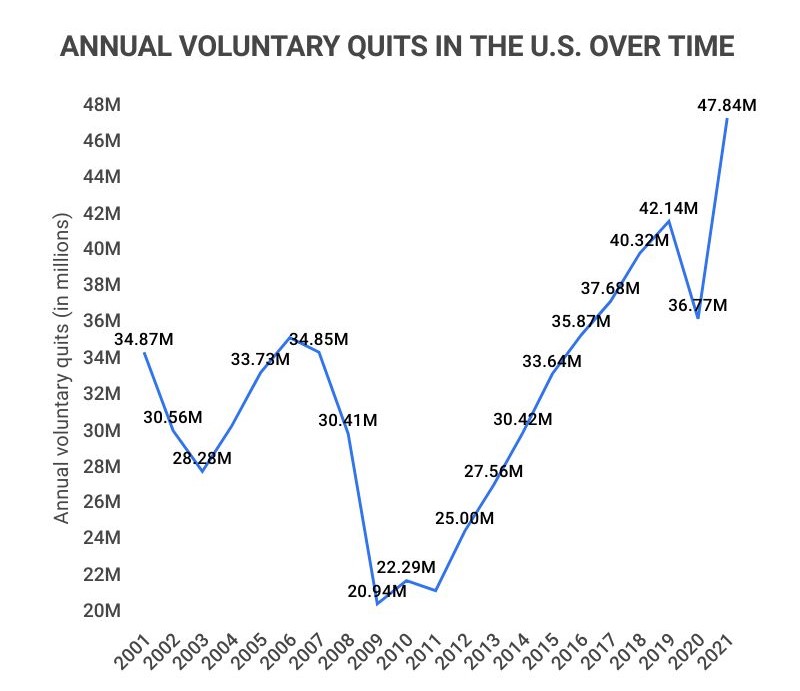Research Summary: For any business that wants to improve productivity and reduce turnover, encouraging employee retention is important. However, this is easier said than done, and many modern companies struggle to retain new employees.
Not only do retention trends affect businesses and companies but also candidates searching on the job market. To find out more, we’ve gathered all of the essential trends and statistics about employee retention in the US. According to our extensive research:
-
69% of employees with a good onboarding experience stay for at least three years.
-
33% of new employees quit within the first six months.
-
Only 39% of HR leaders say retention is their biggest concern.
-
65% of US employees are looking for a new job and believe they could find better pay elsewhere
-
The average annual turnover rate in the US is 57.3%.
For further analysis, we broke down the data in the following ways:
Onboarding | How to Improve | Why Employees Quit | Cost

Onboarding and Employee Retention
Smooth and educational onboarding are essential for building employee retention. To understand more about onboarding and retention are connected, here are some general facts and statistics:
-
64% of employees leave their new jobs because of a poor onboarding experience.
Within the first year of working, the majority of employees will leave a new job when given a poor onboarding experience. This spells disaster for any company that doesn’t prioritize onboarding.
-
Great onboarding increases employee retention by 82%.
While an exceptionally strong onboarding experience will ensure that most employees stay, the effects of standard onboarding are also impressive. By just having a standard onboarding process (great or not), companies increase retention by 50%.
-
Standardized onboarding creates 50% more productive new employees.
Another great perk of standardized onboarding is productive employees, as the process leads to employees who perform tasks faster, safer, and more effectively.
How to Improve Employee Retention
There are many strategies companies can use to improve employee retention. From investing in education to receiving employee feedback, here are some of the most effective ways to do so:
-
94% of employees would stay longer if a company invested in long-term learning.
A majority of employees, regardless of industry, are highly interested in learning and growing in their careers. This presents an important opportunity for employers who want to improve retention.
-
Increased manager transparency increases employee retention by 30%.
Employees want to feel like they can trust their managers and that they’re not in the dark when it comes to company policy and direction. That’s why increased manager transparency improves retention.
-
90% of employees are more likely to stay at a company that takes and acts on employee feedback.
Further, companies that receive employee feedback also experience turnover rates that are reduced by 14.9%. All of this just highlights the massive importance of receiving employee feedback.
-
65% of US employees are happy with their job.
However, only 20% are passionate about their job, meaning companies have some room for improvement in increasing employee interest.
-
Having a remote work option reduces turnover by 25%.
In fact, even just having a hybrid option reduces turnover, as companies that allow their employees to do at least some remote work see turnover reduce by up to 12%.
-
63.3% of HR professionals say it’s actually harder to retain employees rather than recruit them.
Prioritizing employee retention is especially important, given that the majority of companies find it to be more difficult than hiring.
Why Employees Quit
The vast majority of employees don’t quit for no good reason, and understanding the reasons why they quit is important for improving retention. To find out more, here are some key facts about why employees leave a company:
-
21% of employees who don’t feel valued will be searching for a new job within the next year.
Employees who feel underappreciated and undervalued are far more likely to leave, with 66% of all employees saying they would likely leave their job if they felt that way.
-
Between 2011 and 2021, the number of people who voluntarily quit in the US per year increased by over 120%.
In 2011, only 21.68 million Americans quit their jobs over the course of a year. However, that number has been steadily growing each year since reaching a peak of 47.84 million quitters in 2021.
Year Voluntary quits (in millions) 2001 34.87M 2002 30.56M 2003 28.28M 2004 30.76M 2005 33.73M 2006 35.70M 2007 34.85M 2008 30.41M 2009 20.94M 2010 22.29M 2011 21.68M 2012 25.00M 2013 27.56M 2014 30.42M 2015 33.64M 2016 35.87M 2017 37.68M 2018 40.32M 2019 42.14M 2020 36.77M 2021 47.84M -
The annual high-performer turnover rate is only 3%.
High performers are far less likely to quit their jobs, and these numbers are even more prevalent at best-in-class companies, where high-performer turnover is nearly 0%.
-
31% of employees leave their jobs due to toxic company culture.
Work environment plays a key role in why employees quit, and a large portion of those who do feel like their former company’s culture was toxic.
-
70% of employees would leave their job for one with an employee development program.
Another example of just how important learning and growth are to employees, the vast majority would quit their jobs if the new job gave them a better chance to develop their skills.
-
Over 70% of high retention-risk employees would leave their current job to advance their careers.
Similarly to the last stat, the same percentage of employees who are at high risk for leaving anyway would be pushed over the edge if offered opportunities for advancement.
The Cost of Poor Employee Retention
Poor employee retention can come at a hefty financial cost to companies. These costs come in the form of wasted hiring and training costs, salary payments, and more. According to our extensive research:
-
The cost of replacing an employee can range from half to 2x the employee’s annual salary.
In context, this would mean that replacing an employee who makes $60,000 per year can cost companies anywhere between $30,000 to $120,000.
-
US businesses lose $1 trillion annually from poor employee retention.
That’s nearly 4.35% of the entire $23 trillion US GDP, which highlights just how costly poor employee retention really is.
Employee Retention FAQ
-
What is the average employee retention rate?
The average employee retention rate is 47.2%. Generally speaking, this means that just under half of all employees are retained by companies as of 2021, which isn’t fantastic.
Two reasons why this rate is so low are high turnover rates (57.3% on average) and the Great Resignation. In 2021-2022, historic numbers of employees quit their jobs, which has decreased retention rates.
-
What is a good employee retention rate?
A good employee retention rate is 90% or higher. Having a high retention rate like this is important because it saves costs, improves productivity, and breeds exceptional employee loyalty. Combined, all of these factors make a company far more successful.
-
What factors influence employee retention?
There are several factors that influence employee retention. These include
-
Onboarding. Standardized onboarding increases employee retention by 50%, while great onboarding can increase employee retention by up to 82%.
-
Flexibility. This includes things like offering remote work (reduces turnover by 25%) and better scheduling. In turn, the reduced burnout caused by flexibility increases employee retention.
-
Feedback and Improvement. Employees like to have their voices heard, and companies that give their workers a chance to provide feedback see 90% of their employees staying.
-
Growth. Giving employees a chance to learn and grow through programs reduces turnover, as 94% of employees stay longer when companies invest in their careers.
-
Management. Having competent and open management is also crucial for increasing retention, as better manager transparency increases employee retention by 30%.
-
Conclusion
For many years now, maintaining healthy employee retention has seemingly alluded many American companies. Turnover rates have reached 57.3%, and 33% of new employees quit within the first six months.
Further, the Great Resignation hasn’t been helping, with the number of employees quitting per year increased by 120% when compared to a decade ago. Even if this trend might be circumstantial, it’s still a sign of broader issues in the workplace.
Luckily, there are many ways in which these trends can be turned around. When companies put effort into great onboarding, flexibility, employee learning and growth, receiving feedback, and transparent management, they can easily start to improve employee retention.
References
-
Vultus – Why do 33% of the new hires quit within six months?
-
Fortune – Job-hopping heats up: 65% of U.S. workers are looking for a new job
-
Bob – What’s the connection between onboarding and retention?
-
Peoplegoal – Why Great Employee Onboarding Leads to Employee Retention
-
Achievers – What Is Employee Voice and Why Is It Important?
-
Gallup – U.S. Worker Satisfaction With Job Safety Down Amid COVID
-
Workest – Research: Employee Retention a Bigger Problem Than Hiring for Small Business
-
APA – APA Survey Finds Feeling Valued at Work Linked to Well-Being and Performance
-
Forbes – 66% Of Employees Would Quit If They Feel Unappreciated
-
SHRM – Interactive Chart: How Historic Has the Great Resignation Been?
-
Real Estate Witch – 2022 Data: Toxic Company Culture Is Fueling the Great Resignation
-
Gallup – This Fixable Problem Costs U.S. Businesses $1 Trillion
- Statistics
- Employee Retention Statistics
- Happy Employees Are More Productive
- Workplace Distraction Statistics
- Average Freelancer Rates
- Average Working Hours
- Offboarding Statistics
- Employee Productivity Statistics
- Workplace Microagression Statistics
- Employee Monitoring Statistics
- Employee Training And Development Statistics
- Lead Generation Statistics





